


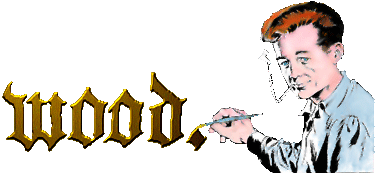 |
||
Wally Wood grew up wanting to be a cartoonist. Born in 1927, he studied at the feet of the master cartoonists of his day. Every week saw the delivery of another course brightly wrapped around the Sunday newspaper. He did manage to spend some time at the Cartoonists and Illustrators School in New York and as an assistant to George Wunder who was drawing Terry and The Pirates. Early in 1949 he found Renaldo Epworth who brokered comic book stories for some of the low-end publishers. Wood was officially drawing comics!

Hidden behind the verbiage and cramped art in the first panel above is probably the first appearance of Wally Wood's signature in a comic book. The "Woody" sneaked into the marquee is from a Fox romance comic, My Confession, from October of 1949. He was barely 22 and fresh out of the Merchant Marine when Epworth teamed him up with two separate aspiring young cartoonists, Marty Rose and Harry Harrison, to produce a spate of stories for Fox in 1949 and 1950. Rose went on to oblivion, Harrison to a long career as a science fiction writer, and Wood to a checkered and impressive career as one of the most famous and influential comic book artists in history. It started with a meteoric rise to stardom.
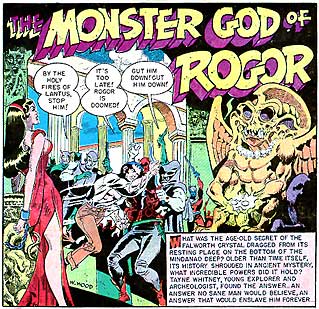 In
1950, while still churning out hackneyed romance, crime and adventure
comics for Victor Fox at minimum wage, he branched out to other
companies. EC was publishing some romance comics and Harrison
got the team some jobs, but the publishers soon figured out that
it was Wood who they wanted to hire. In 1950, when they started
their unforgettable science fiction comics, Weird Fantasy
and Weird Science, Wood was an immediate regular. But that
didn't stop him from working for other companies like Youthful
where in November of 1950, barely a year later, he was capable
of fantasy work like the image at right from Youthful's Capt.
Science #1. Throughout 1950 and 1951, he produced work for
Youthful, Avon, Trojan, Ziff-Davis, Standard, ACG, EC and anyone
else who would give him work. And boy did he get work. He's even
got illustrations in some late issues of Planet Stories
pulp.
In
1950, while still churning out hackneyed romance, crime and adventure
comics for Victor Fox at minimum wage, he branched out to other
companies. EC was publishing some romance comics and Harrison
got the team some jobs, but the publishers soon figured out that
it was Wood who they wanted to hire. In 1950, when they started
their unforgettable science fiction comics, Weird Fantasy
and Weird Science, Wood was an immediate regular. But that
didn't stop him from working for other companies like Youthful
where in November of 1950, barely a year later, he was capable
of fantasy work like the image at right from Youthful's Capt.
Science #1. Throughout 1950 and 1951, he produced work for
Youthful, Avon, Trojan, Ziff-Davis, Standard, ACG, EC and anyone
else who would give him work. And boy did he get work. He's even
got illustrations in some late issues of Planet Stories
pulp.
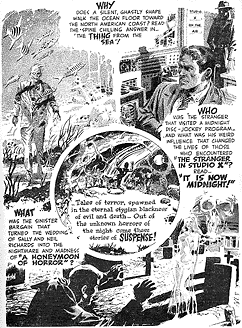 In
addition to sf stories like An Earth Man on Venus, Avon
had him doing the inside front cover of many of their comics.
It was a b&w image that gave a preview of the stories in the
book. It was in these promotional pieces that Wood began a long
association with Craftint, an art board that produced two different
tones of gray depending on which fluid you used to paint on it.
You can see an example at the left from Avon's Eerie #1
from August 1951.
In
addition to sf stories like An Earth Man on Venus, Avon
had him doing the inside front cover of many of their comics.
It was a b&w image that gave a preview of the stories in the
book. It was in these promotional pieces that Wood began a long
association with Craftint, an art board that produced two different
tones of gray depending on which fluid you used to paint on it.
You can see an example at the left from Avon's Eerie #1
from August 1951.
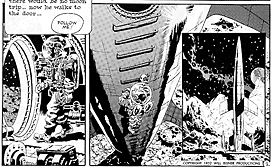
By that time Wood was already hard at work on a new comic book for EC - one that brought out another facet of his talents. That comic was MAD. Mr. "science fiction" just turned into Mr. nutty. Harvey Kurtzman was the heart of MAD and Will Elder was the manic bloodstream feeding that heart, but Wally Wood was MAD's soul. The spirit of the magazine didn't really surface until Wood produced a classic series of comic book parodies in issues 4-8. Starting with Superduperman in #4 and progressing through Black and Blue Hawks, Teddy and the Pirates, Smilin' Melvin and the mind-numbing Batboy and Rubin in #8, the lampoon style and the popular culture target were firmly established. Except for the penultimate comic issue that featured only Will Elder, Wood was in every issue of the comic and continued to work for MAD for years after its transformation to a magazine in 1955. He was still there in the early sixties, with art in every issue up to #86. Below is a sample from V-Vampires in issue #3.

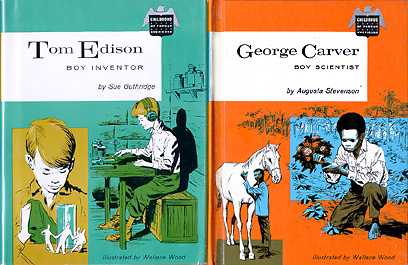
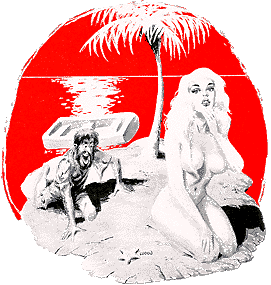 As the Fifties
wore on, comics wore off. With the market for comic books shrinking,
Wood turned to more traditional illustrative markets. He did dust
jackets for science fiction books, illustrated children's books
like the ones at left and
did some advertising illustration. He got work doing cartoons
for men's magazine with names like The Dude, Gent,
and Nugget (see "At Last! A human face!"
at right)", helped Jack
Kirby by doing the inking on his Sky Masters
newspaper strip and his Challengers of the Unknown comic
book, but his main outlet was the science fiction digests, most
notably Galaxy Science Fiction. There he did covers and
interior drawings, sometimes doing the art for three stories in
one issue. He also did covers for four books in a series of paperbacks
they published. It wasn't comics, but it was drawing (see samples
below) and it paid the bills - barely. Many of comics most important
artists were looking elsewhere for employment during the late
Fifties and early Sixties. Wood wasn't alone in this shifting
market.
As the Fifties
wore on, comics wore off. With the market for comic books shrinking,
Wood turned to more traditional illustrative markets. He did dust
jackets for science fiction books, illustrated children's books
like the ones at left and
did some advertising illustration. He got work doing cartoons
for men's magazine with names like The Dude, Gent,
and Nugget (see "At Last! A human face!"
at right)", helped Jack
Kirby by doing the inking on his Sky Masters
newspaper strip and his Challengers of the Unknown comic
book, but his main outlet was the science fiction digests, most
notably Galaxy Science Fiction. There he did covers and
interior drawings, sometimes doing the art for three stories in
one issue. He also did covers for four books in a series of paperbacks
they published. It wasn't comics, but it was drawing (see samples
below) and it paid the bills - barely. Many of comics most important
artists were looking elsewhere for employment during the late
Fifties and early Sixties. Wood wasn't alone in this shifting
market.


Woody came back to comic books with the success of Marvel in the mid-Sixties. In late '64 through early '66 he drew their Daredevil title. Then he created and packaged a series of comic books for Tower featuring characters he created. These were the T.H.U.N.D.E.R. Agents and featured Dynamo, Noman, Lightning, the Raven and others. They lasted for nearly three years, but Woody seemed to bow out after two. This seemed often to be the case in his career as it is studded with short creative bursts that seem to end abruptly, with the very obvious exception of MAD.
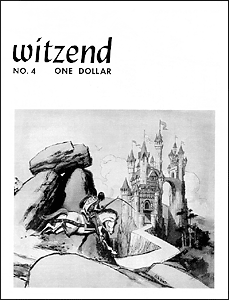 The
most important occurrence in 1966 was the publication of Witzend
#1. The sixties were a hotbed of fan activity. Called "fanzines", dozens
of amateur magazines devoted to the
medium were being published, some on a fairly regular schedule. A community
was developing with occasional contact with the professional world
in the form of donated art or interviews. Wood turned everything
on its ear when he published his own fanzine with finished, professional
contributions by many of fandom's most popular artists. It was
the first magazine that was outspokenly in favor of the rights
of the creators (which had always been subsumed to those of the
publishers). Witzend allowed the artists to copyright their
creations, a practice unheard of in those days. Fans coined a
new word for Witzend, it was the first "prozine".
He published six issues through 1969 and debuted a half-dozen
characters and strips of his own, including The Wizard King
which first appeared in issue #4.
The
most important occurrence in 1966 was the publication of Witzend
#1. The sixties were a hotbed of fan activity. Called "fanzines", dozens
of amateur magazines devoted to the
medium were being published, some on a fairly regular schedule. A community
was developing with occasional contact with the professional world
in the form of donated art or interviews. Wood turned everything
on its ear when he published his own fanzine with finished, professional
contributions by many of fandom's most popular artists. It was
the first magazine that was outspokenly in favor of the rights
of the creators (which had always been subsumed to those of the
publishers). Witzend allowed the artists to copyright their
creations, a practice unheard of in those days. Fans coined a
new word for Witzend, it was the first "prozine".
He published six issues through 1969 and debuted a half-dozen
characters and strips of his own, including The Wizard King
which first appeared in issue #4.
Wood was unstinting in his support for young artists trying to break into the field. Many served as his "assistants" during the 1960's and 70's on a variety of projects. These included a trio of strips in 1972-74 for The Overseas Weekly, a publication for servicemen. In between the pinups, Wood and company showcased Cannon (a sexy, spy adventure strip) and Sally Forth (a sexy humor strip). Both were eventually compiled into magazine format by Wood himself. The third strip, Shattuck, was a sexy western and a lot of it was drawn by a young Howard Chaykin.
From 1969 to 1976, Wood returned to comic books working for Charlton, DC, Marvel, Warren, the short-lived Atlas/Seaboard, and even one appearance at MAD. He produced some fine solo work, but the majority of the stories involved only inking for other artists. He was a polished and prolific inker and won several awards for his skills. Twenty years into his career, he was already a has-been. He abandoned the field to produce and publish his own work. The Wizard King was rescued from the old Witzend magazines and compiled into a hardbound book in 1978. It was followed by the next chapter, Odkin Son of Odkin in 1981. The third chapter was never published as Wood decided to abandon life rather than face an uncertain future on a dialysis machine.
In 1981, he shot himself, leaving his fans and comics poorer for his absence. The last years of his life were a sad commentary on how far he had fallen out of favor. Faced with fits of depression and bouts with alcoholism, he found work primarily in the hardcore lampoons of his once heroes. Wood, who actually was considered as a replacement for Hal Foster on Prince Valiant (and actually had his trial page published on November 15, 1970), was reduced to creating x-rated parodies of Valiant, Flash Gordon, Tarzan and even Alice in Wonderland for publications like National Screw. The humor was low and so was the artistic energy. Wood's life was ebbing before our eyes. If the first five years of his career were meteoric in relation to his artistic development, the last five went down nearly as fast.

To learn more about Wally Wood, see:
| The Who's Who of American Comic Books | Jerry Bails & Hames Ware, 1976 |
| The Wallace Wood Treasury | Greg Theakston, 1980 Pure Imagination |
| The Comics Journal #197 - Wallace Wood | Bhob Stewart, 1997 Fantagraphics |
| The Vadeboncoeur Collection of Knowledge | Jim Vadeboncoeur, Jr. 1998 |
|
Illustrations are copyright by their
respective owners. This page written, designed & © 1998 by Jim Vadeboncoeur, Jr. Updated 2011. |
